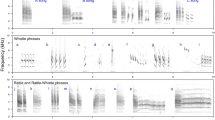Summary
Female cowbirds (Molothrus ater ater), maintained in isolation from males during the breeding season, respond to the playback of male song with copulatory postures. They respond to some songs more than to others. Cowbird song potency can thus be operationally defined by the proportion of copulatory postures a song elicits across multiple playbacks. The purpose of the present study was to explore whether song potency changes with distance in the field. No field recordings elicited high levels of responding by the females. When songs of known high potency are systematically degraded, the results indicate that female cowbirds are sensitive to small changes in signal to noise ratio and to atmospheric attenuation. The data suggest that cowbird song potency degrades very rapidly with transmission distance in the field.
Similar content being viewed by others
References
Bremond JC (1968) Recherches sur la semantique et les elements vecteurs d'information dans les signaux acoustiques du rougegorge (Erithacus rubecula L.). Terre Vie 22:109–220
Chappuis C (1971) Un example de l'influence du milieu sur les émmissions vocales des oiseaux: l'évolution des chantes en forêt équatoriale. Terre Vie 25:183–202
Darley JA (1968) The social organization of breeding brown-headed cowbirds. PhD thesis, University of Western Ontario, London
Darley JA (1978) Pairing in captive brown-headed cowbirds (Molothrus ater). Can J Zool 56:2249–2252
Dufty AM (1979) Response of brown-headed cowbirds to playbacks of cowbird vocalizations. Paper No. 137 presented at American Ornithologists' Union meeting, College Station, Texas
Greenwalt C (1968) Bird song: Acoustics and physiology. Smithsonian Institution, Washington, DC
Heinz RD, Sinnott JM, Sachs MB (1977) Auditory sensitivity of the redwing blackbird (Agelaius phoeniceus) and brown-headed cowbird (Molothrus ater). J Comp Physiol Psychol 91:1365–1376
King AP, West MJ (1977) Species identification in the N.A. cowbird: Appropriate responses to abnormal seng. Science 195:1002–1004
King AP, West MJ, Eastzer DH (1980) Song structure and song development as potential contributors to reproductive isolation in cowbirds (Molothrus ater). J Comp Physiol Psychol 94:1028–1039
Laskey A (1950) Cowbird behavior. Wilson Bull 62:157–174
Marten K, Marler P (1977) Sound transmission and its significance for animal vocalization: I. Temperate habitats. Behav Ecol Sociobiol 2:271–290
Marten K, Quine D, Marler P (1977) Sound transmission and its significance for animal vocalization: II. Tropical forest habitats. Behav Ecol Sociobiol 2:291–302
Michelsen A (1978) Sound reception in different environments. In: Ali MA (ed) Sensory ecology review and perspectives. Plenum, New York
Morton E (1975) Ecological sources of selection on avian sounds. Am Nat 108:17–34
Payne RB (1973) The breeding season of a parasitic bird, the brown-headed cowbird, in central California. Condor 75:80–99
Richards DG (1978) Environmental acoustics and song communication in passerine birds. PhD thesis, University of North Carolina, Chapel Hill
Richards DG, Wiley RH (1980) Reverberations and amplitude fluctuations in the propagation of sound in a forest: Implications for animal communication. Am Nat 115:381–399
Schubert M (1971) Experimentelle Untersuchungen über die reaktionsauslösenden Signalstrukturen des Fitis-Gesanges, Phylloscopus t. trochilus. L., und das Verhalten gegenüber arteigenen Rufen. Behaviour 38:250–288
Shiovitz KA (1975) The process of species-specific song recognition by the indigo bunting, Passerina cyanea, and its relationship to the organization of avian acoustical behaviour. Behaviour 55:128–179
Waser PM, Waser MS (1977) Experimental studies of primate vocalizations for long-distance propagation. Z Tierpsychol 43:239–263
West MJ, King AP (1980) Enriching cowbird song by social deprivation. J Comp Physiol Psychiol 94:263–270
West MJ, King AP, Eastzer DH, Staddon JER (1979) A bioassay of isolate cowbird song. J Comp Physiol Psychol 93:124–133
West MJ, King AP, Eastzer DH (1981) Validating the female bioassay of cowbird song: Relating differences in song potency to mating success. Anim Behav 29:490–501
Wiley RH, Richards DR (1978) Physical constraints on acoustic communication in the atmosphere: Implications for the evolution of animal vocalizations. Behav Ecol Sociobiol 3:69–94
Author information
Authors and Affiliations
Rights and permissions
About this article
Cite this article
King, A.P., West, M.J., Eastzer, D.H. et al. An experimental investigation of the bioacoustics of cowbird song. Behav Ecol Sociobiol 9, 211–217 (1981). https://doi.org/10.1007/BF00302940
Received:
Accepted:
Issue Date:
DOI: https://doi.org/10.1007/BF00302940




